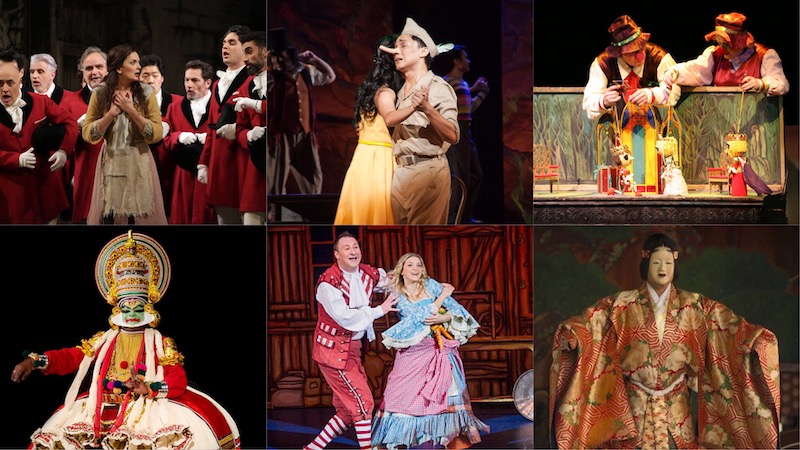
8 Traditional Theater Practices Around the World
When we think of going to the theater, we probably have similar ideas of seeing a musical, a ballet, or a dramatic play. But there are many more theater traditions around the world, each rich in history and culture. Here are some of them.
1. Japan: Noh
One of the oldest classical traditions of world theater, Noh plays are known for their strength and poetic beauty. They are presented on simple wooden stages but use elaborate make-up, masks, and costumes, and combine chanting, music, and dance. Traditionally, performers are all male, though recently female actors have also taken part. In Noh theater, facial expressions are considered vulgar, so actors who don’t wear masks must keep their faces expressionless.
2. Nigeria: Yoruba Theater
This style of theater is a variety of the folk opera of the Yoruba people of southwestern Nigeria. It’s fairly new, having come up in the 1940s, and combines mime, traditional drumming, colorful costumes, and folklore. It focuses on satire of Yoruba types such as the jealous husband or stingy father, Nigerian politics, and historical tragedy.
3. India: Kathakali
There are many styles of theater in India, with different regions making their contribution. Kathakali comes from the southern region of Kerala, and is based on one of the two famous Sanskrit epics: the Mahābhārata (Ramayana being the other). It’s a genre of classical Indian dance, and is traditionally performed by male dancers. It relies on athletic movement, dramatic gestures and facial expressions aided by intricate makeup and unique face masks. Kathakali is heavy on surrealism, with characters representing gods, demons, saints, and animals.
4. United Kingdom: Pantomime
The pantomime, fondly called panto by the British, is a lighthearted comic play often based on fairy tales or nursery rhymes. It incorporates music hall traditions as well as eccentric humor. It’s often put on during the Christmas holidays, and though it may seem like it’s only for children, the panto is entertaining for all audiences because of its comedic nature. These days soap stars, comedians, and reality show winners perform in pantos.
5. Italy: Opera
Italian Opera began in Florence in the 1500s, taking elements of Greek drama and madrigals or a capella singing. Traditional operas are known for their dramatic style, and consist of two styles of singing: recitative, which is more similar to speech; and aria, which is the formal set piece aimed to highlight the solo singer. Some of the most famous operas that are still performed today are Puccini’s La Boheme and Madama Butterfly, and Verdi’s Aida and La Traviata.
6. Brazil: Theater of the Oppressed
Brazilian theater director and political activist Augusto Boal created this type of theater, which can be described as a mix of performance, workshop, and forum. Audiences watching Theater of the Oppressed should expect to be part of the presentation and work with the actors to discuss such issues as poverty, inequality, sexism, or racism. A facilitator oversees the performance, but unlike other traditional plays, this type of performance has no conclusion that neatly wraps up the plot. It leans toward revolution and motivating people to take action.
7. Russia: Puppet Theater
The origins of this type of theater stretch as far back as the sixth century, from ancient customs using masks and dummies during festivals. Materials have evolved from simple hand puppets to wood and metal puppets, to the more intricate marionnettes today. Performance styles have also evolved to include shadow plays using silhouettes.
8. Philippines: Sarsuwela
This style of theater is a holdover from the days of Spanish colonization. The dramatic action in a Sarsuwela moves forward with words being alternately spoken and sung in operatic and popular styles. It also incorporates vocal ensemble numbers like trios or duets, and folk music and dance. National hero Jose Rizal was reportedly fond of Sarsuwelas. The name comes from the royal hunting lodge of Spanish King Philip IV, which was called La Zarzuela, and where the first performances were held.

